ACC508: Information Systems, Decision Support for B Bakery's Success
VerifiedAdded on 2019/11/26
|22
|4274
|168
Report
AI Summary
This report provides a comprehensive analysis of Accounting Information Systems (AIS) and Enterprise Resource Planning (ERP) systems tailored for a medium-sized bakery, referred to as B Bakery. The report begins with an executive summary, followed by a detailed examination of the bakery's business processes, including supply chain management, production, inventory, sales and marketing, finance and accounting, IT, and human resources. It then outlines the business requirements, focusing on accounting, inventory management, supply chain efficiency, production optimization, and sales management. The report further details the system requirements for an ERP system, emphasizing inventory tracking, shelf-life management, product costing, and sales forecasting. Additionally, the report discusses the requirements for an Accounting Information System (AIS), highlighting the need for integration and improved financial management. The report concludes with a discussion of software and vendor selection, offering recommendations for the most suitable solutions to enhance B Bakery's operational efficiency and decision-making processes. The report aims to provide a practical framework for implementing AIS and ERP systems to improve the bakery's profitability and overall business performance.
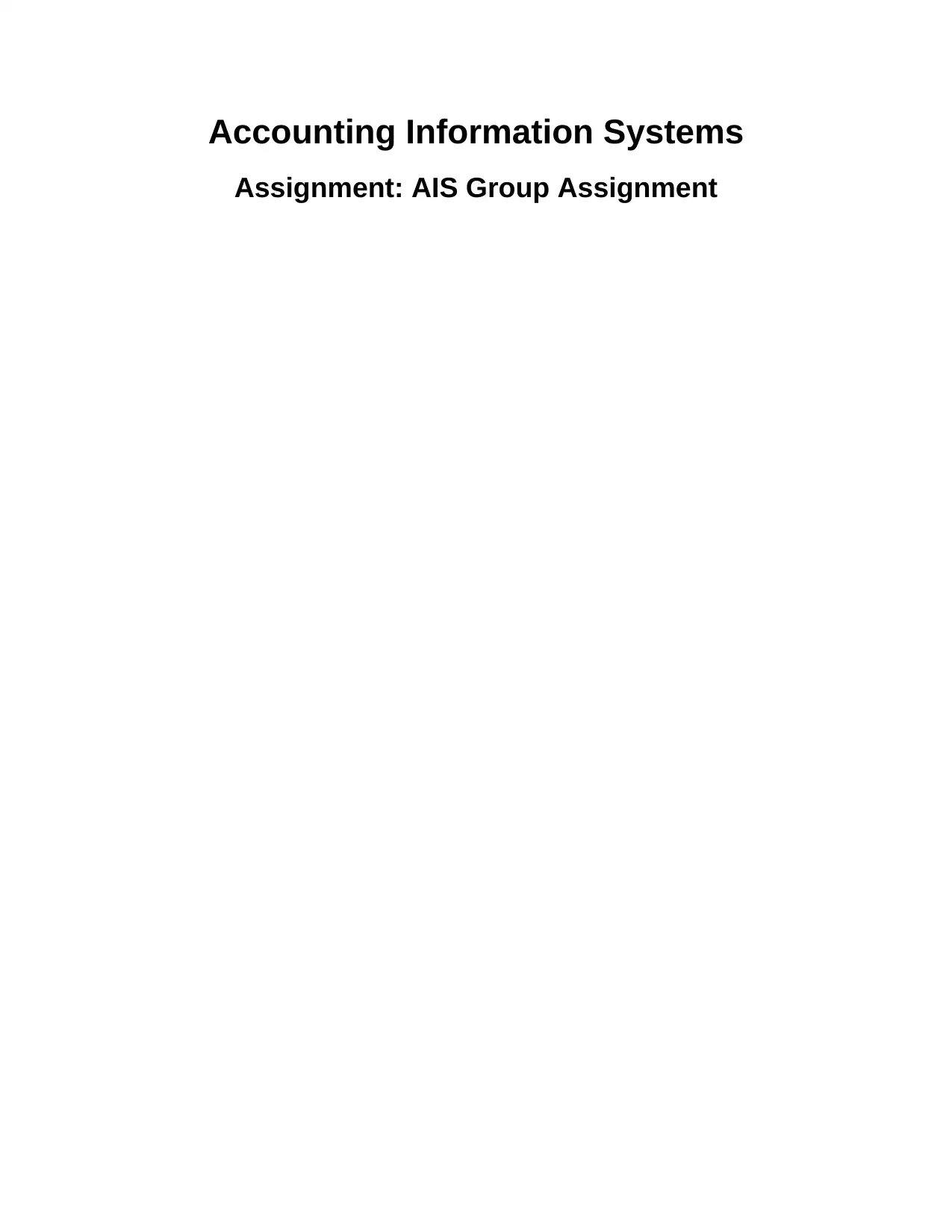
Accounting Information Systems
Assignment: AIS Group Assignment
Assignment: AIS Group Assignment
Paraphrase This Document
Need a fresh take? Get an instant paraphrase of this document with our AI Paraphraser
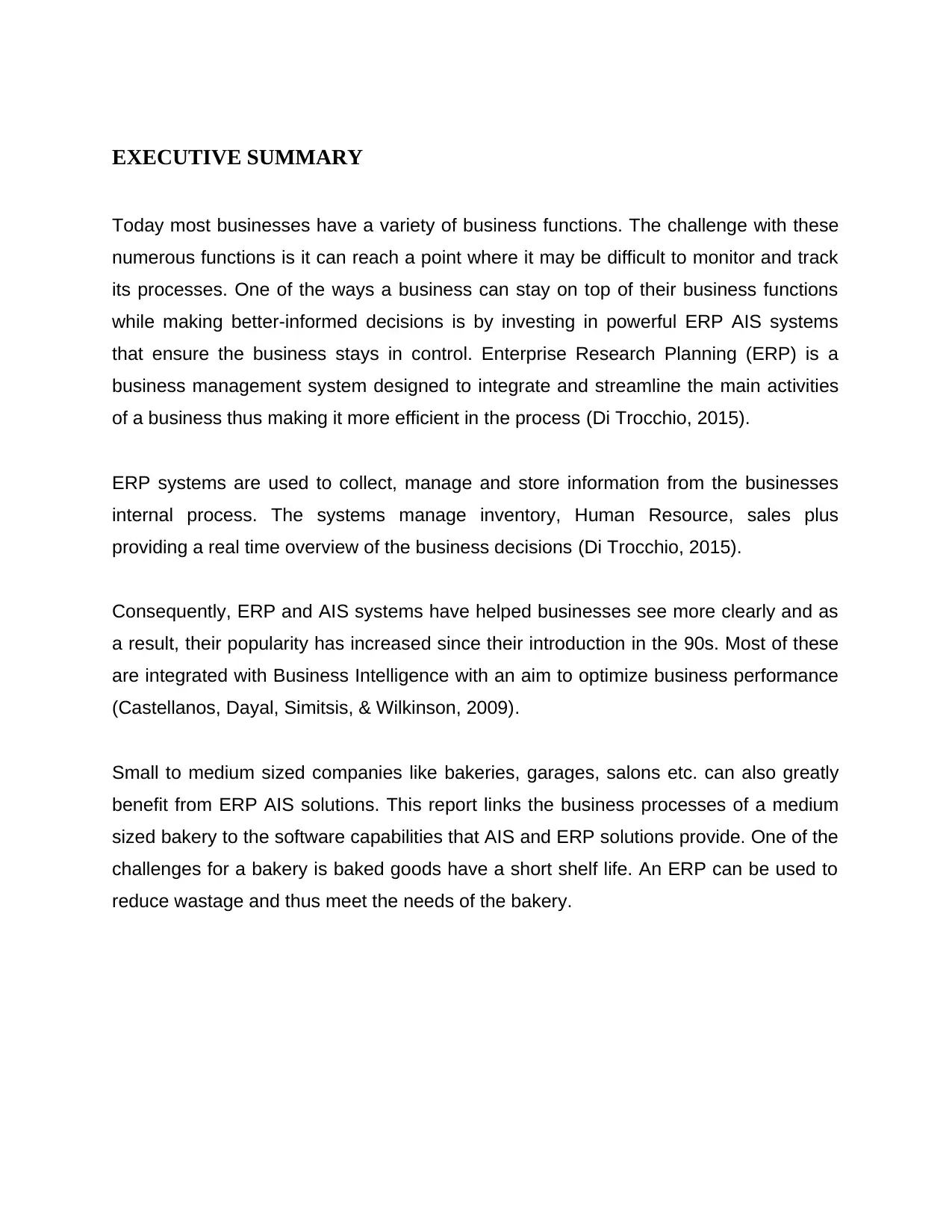
EXECUTIVE SUMMARY
Today most businesses have a variety of business functions. The challenge with these
numerous functions is it can reach a point where it may be difficult to monitor and track
its processes. One of the ways a business can stay on top of their business functions
while making better-informed decisions is by investing in powerful ERP AIS systems
that ensure the business stays in control. Enterprise Research Planning (ERP) is a
business management system designed to integrate and streamline the main activities
of a business thus making it more efficient in the process (Di Trocchio, 2015).
ERP systems are used to collect, manage and store information from the businesses
internal process. The systems manage inventory, Human Resource, sales plus
providing a real time overview of the business decisions (Di Trocchio, 2015).
Consequently, ERP and AIS systems have helped businesses see more clearly and as
a result, their popularity has increased since their introduction in the 90s. Most of these
are integrated with Business Intelligence with an aim to optimize business performance
(Castellanos, Dayal, Simitsis, & Wilkinson, 2009).
Small to medium sized companies like bakeries, garages, salons etc. can also greatly
benefit from ERP AIS solutions. This report links the business processes of a medium
sized bakery to the software capabilities that AIS and ERP solutions provide. One of the
challenges for a bakery is baked goods have a short shelf life. An ERP can be used to
reduce wastage and thus meet the needs of the bakery.
Today most businesses have a variety of business functions. The challenge with these
numerous functions is it can reach a point where it may be difficult to monitor and track
its processes. One of the ways a business can stay on top of their business functions
while making better-informed decisions is by investing in powerful ERP AIS systems
that ensure the business stays in control. Enterprise Research Planning (ERP) is a
business management system designed to integrate and streamline the main activities
of a business thus making it more efficient in the process (Di Trocchio, 2015).
ERP systems are used to collect, manage and store information from the businesses
internal process. The systems manage inventory, Human Resource, sales plus
providing a real time overview of the business decisions (Di Trocchio, 2015).
Consequently, ERP and AIS systems have helped businesses see more clearly and as
a result, their popularity has increased since their introduction in the 90s. Most of these
are integrated with Business Intelligence with an aim to optimize business performance
(Castellanos, Dayal, Simitsis, & Wilkinson, 2009).
Small to medium sized companies like bakeries, garages, salons etc. can also greatly
benefit from ERP AIS solutions. This report links the business processes of a medium
sized bakery to the software capabilities that AIS and ERP solutions provide. One of the
challenges for a bakery is baked goods have a short shelf life. An ERP can be used to
reduce wastage and thus meet the needs of the bakery.
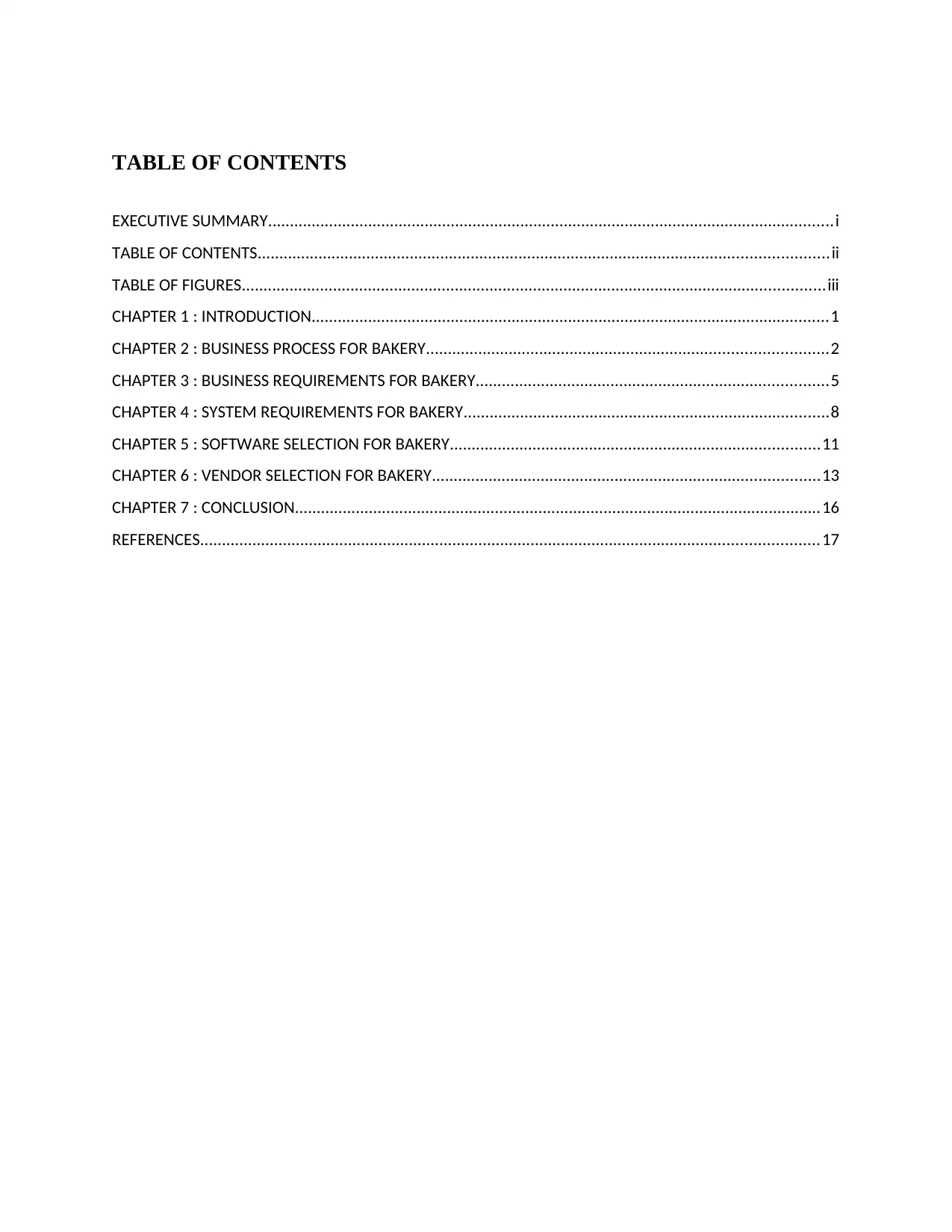
TABLE OF CONTENTS
EXECUTIVE SUMMARY..................................................................................................................................i
TABLE OF CONTENTS...................................................................................................................................ii
TABLE OF FIGURES......................................................................................................................................iii
CHAPTER 1 : INTRODUCTION.......................................................................................................................1
CHAPTER 2 : BUSINESS PROCESS FOR BAKERY............................................................................................2
CHAPTER 3 : BUSINESS REQUIREMENTS FOR BAKERY.................................................................................5
CHAPTER 4 : SYSTEM REQUIREMENTS FOR BAKERY....................................................................................8
CHAPTER 5 : SOFTWARE SELECTION FOR BAKERY.....................................................................................11
CHAPTER 6 : VENDOR SELECTION FOR BAKERY.........................................................................................13
CHAPTER 7 : CONCLUSION.........................................................................................................................16
REFERENCES..............................................................................................................................................17
EXECUTIVE SUMMARY..................................................................................................................................i
TABLE OF CONTENTS...................................................................................................................................ii
TABLE OF FIGURES......................................................................................................................................iii
CHAPTER 1 : INTRODUCTION.......................................................................................................................1
CHAPTER 2 : BUSINESS PROCESS FOR BAKERY............................................................................................2
CHAPTER 3 : BUSINESS REQUIREMENTS FOR BAKERY.................................................................................5
CHAPTER 4 : SYSTEM REQUIREMENTS FOR BAKERY....................................................................................8
CHAPTER 5 : SOFTWARE SELECTION FOR BAKERY.....................................................................................11
CHAPTER 6 : VENDOR SELECTION FOR BAKERY.........................................................................................13
CHAPTER 7 : CONCLUSION.........................................................................................................................16
REFERENCES..............................................................................................................................................17
⊘ This is a preview!⊘
Do you want full access?
Subscribe today to unlock all pages.

Trusted by 1+ million students worldwide
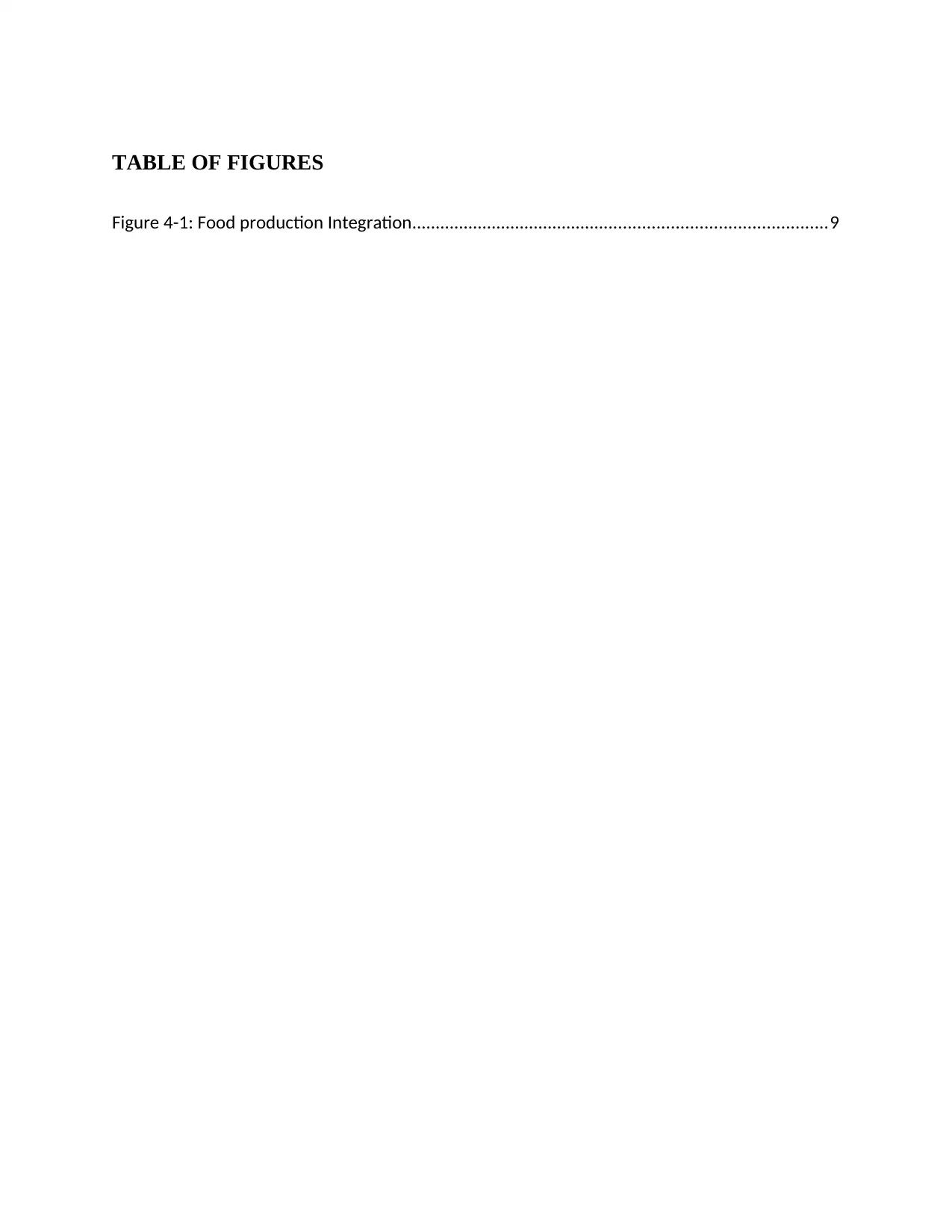
TABLE OF FIGURES
Figure 4-1: Food production Integration........................................................................................9
Figure 4-1: Food production Integration........................................................................................9
Paraphrase This Document
Need a fresh take? Get an instant paraphrase of this document with our AI Paraphraser
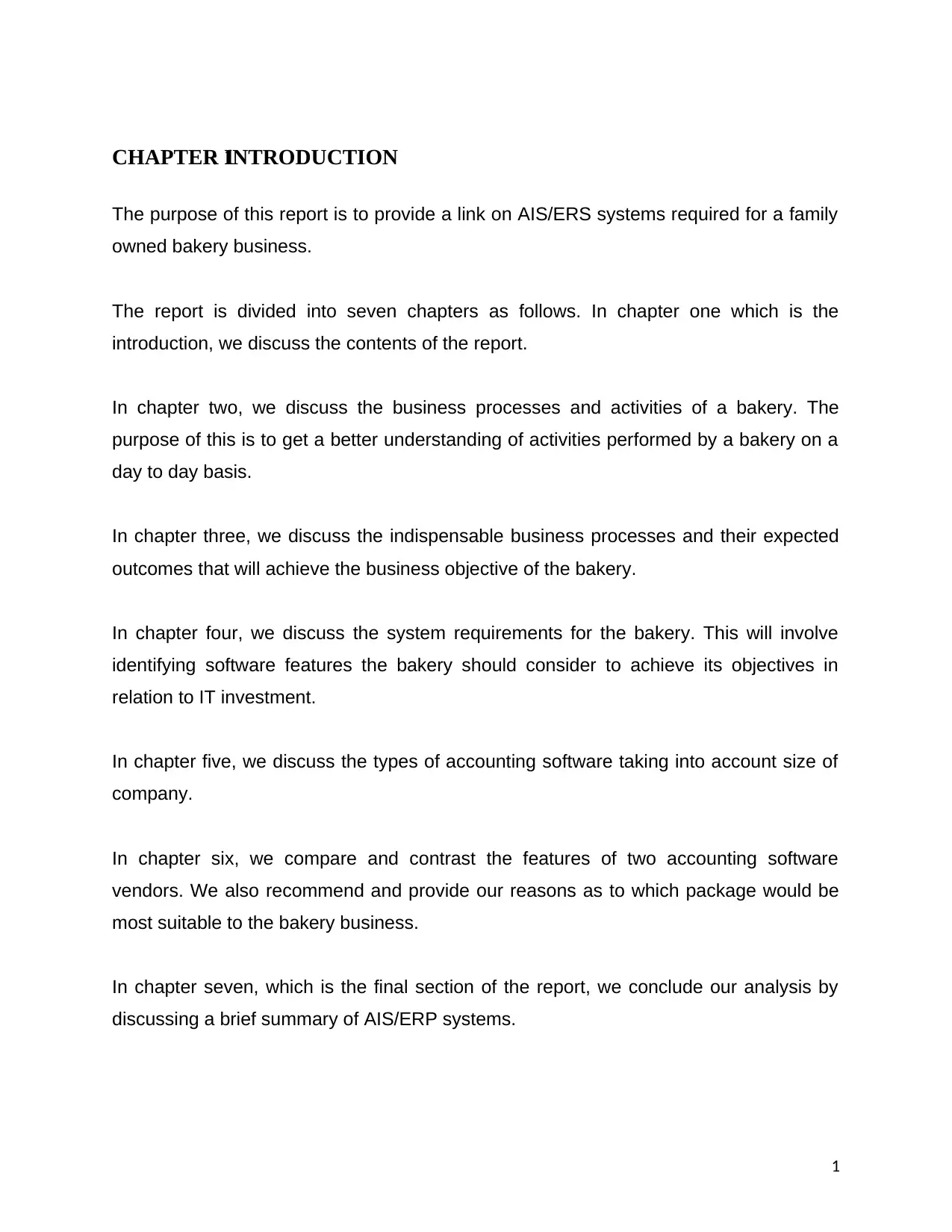
CHAPTER 1: INTRODUCTION
The purpose of this report is to provide a link on AIS/ERS systems required for a family
owned bakery business.
The report is divided into seven chapters as follows. In chapter one which is the
introduction, we discuss the contents of the report.
In chapter two, we discuss the business processes and activities of a bakery. The
purpose of this is to get a better understanding of activities performed by a bakery on a
day to day basis.
In chapter three, we discuss the indispensable business processes and their expected
outcomes that will achieve the business objective of the bakery.
In chapter four, we discuss the system requirements for the bakery. This will involve
identifying software features the bakery should consider to achieve its objectives in
relation to IT investment.
In chapter five, we discuss the types of accounting software taking into account size of
company.
In chapter six, we compare and contrast the features of two accounting software
vendors. We also recommend and provide our reasons as to which package would be
most suitable to the bakery business.
In chapter seven, which is the final section of the report, we conclude our analysis by
discussing a brief summary of AIS/ERP systems.
1
The purpose of this report is to provide a link on AIS/ERS systems required for a family
owned bakery business.
The report is divided into seven chapters as follows. In chapter one which is the
introduction, we discuss the contents of the report.
In chapter two, we discuss the business processes and activities of a bakery. The
purpose of this is to get a better understanding of activities performed by a bakery on a
day to day basis.
In chapter three, we discuss the indispensable business processes and their expected
outcomes that will achieve the business objective of the bakery.
In chapter four, we discuss the system requirements for the bakery. This will involve
identifying software features the bakery should consider to achieve its objectives in
relation to IT investment.
In chapter five, we discuss the types of accounting software taking into account size of
company.
In chapter six, we compare and contrast the features of two accounting software
vendors. We also recommend and provide our reasons as to which package would be
most suitable to the bakery business.
In chapter seven, which is the final section of the report, we conclude our analysis by
discussing a brief summary of AIS/ERP systems.
1
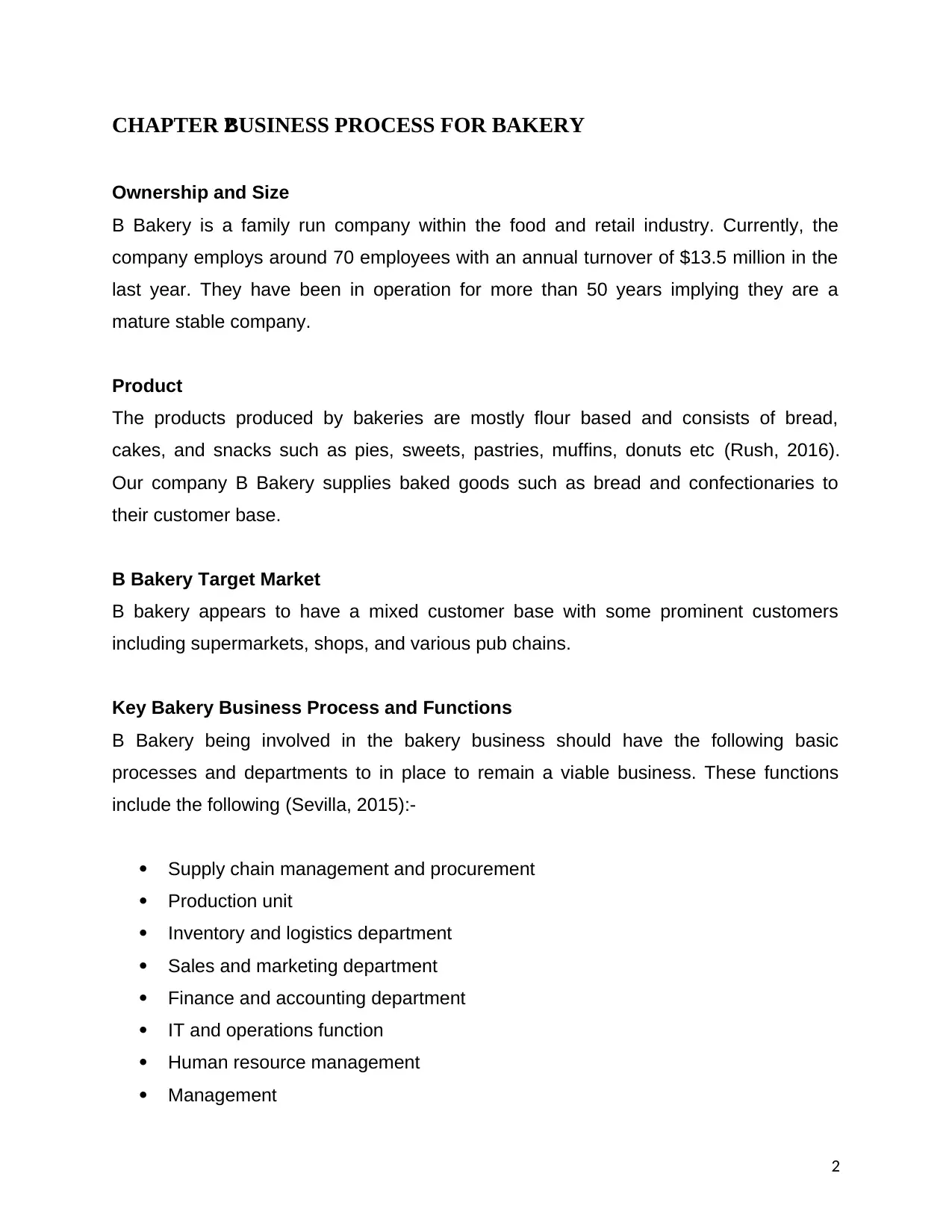
CHAPTER 2: BUSINESS PROCESS FOR BAKERY
Ownership and Size
B Bakery is a family run company within the food and retail industry. Currently, the
company employs around 70 employees with an annual turnover of $13.5 million in the
last year. They have been in operation for more than 50 years implying they are a
mature stable company.
Product
The products produced by bakeries are mostly flour based and consists of bread,
cakes, and snacks such as pies, sweets, pastries, muffins, donuts etc (Rush, 2016).
Our company B Bakery supplies baked goods such as bread and confectionaries to
their customer base.
B Bakery Target Market
B bakery appears to have a mixed customer base with some prominent customers
including supermarkets, shops, and various pub chains.
Key Bakery Business Process and Functions
B Bakery being involved in the bakery business should have the following basic
processes and departments to in place to remain a viable business. These functions
include the following (Sevilla, 2015):-
Supply chain management and procurement
Production unit
Inventory and logistics department
Sales and marketing department
Finance and accounting department
IT and operations function
Human resource management
Management
2
Ownership and Size
B Bakery is a family run company within the food and retail industry. Currently, the
company employs around 70 employees with an annual turnover of $13.5 million in the
last year. They have been in operation for more than 50 years implying they are a
mature stable company.
Product
The products produced by bakeries are mostly flour based and consists of bread,
cakes, and snacks such as pies, sweets, pastries, muffins, donuts etc (Rush, 2016).
Our company B Bakery supplies baked goods such as bread and confectionaries to
their customer base.
B Bakery Target Market
B bakery appears to have a mixed customer base with some prominent customers
including supermarkets, shops, and various pub chains.
Key Bakery Business Process and Functions
B Bakery being involved in the bakery business should have the following basic
processes and departments to in place to remain a viable business. These functions
include the following (Sevilla, 2015):-
Supply chain management and procurement
Production unit
Inventory and logistics department
Sales and marketing department
Finance and accounting department
IT and operations function
Human resource management
Management
2
⊘ This is a preview!⊘
Do you want full access?
Subscribe today to unlock all pages.

Trusted by 1+ million students worldwide
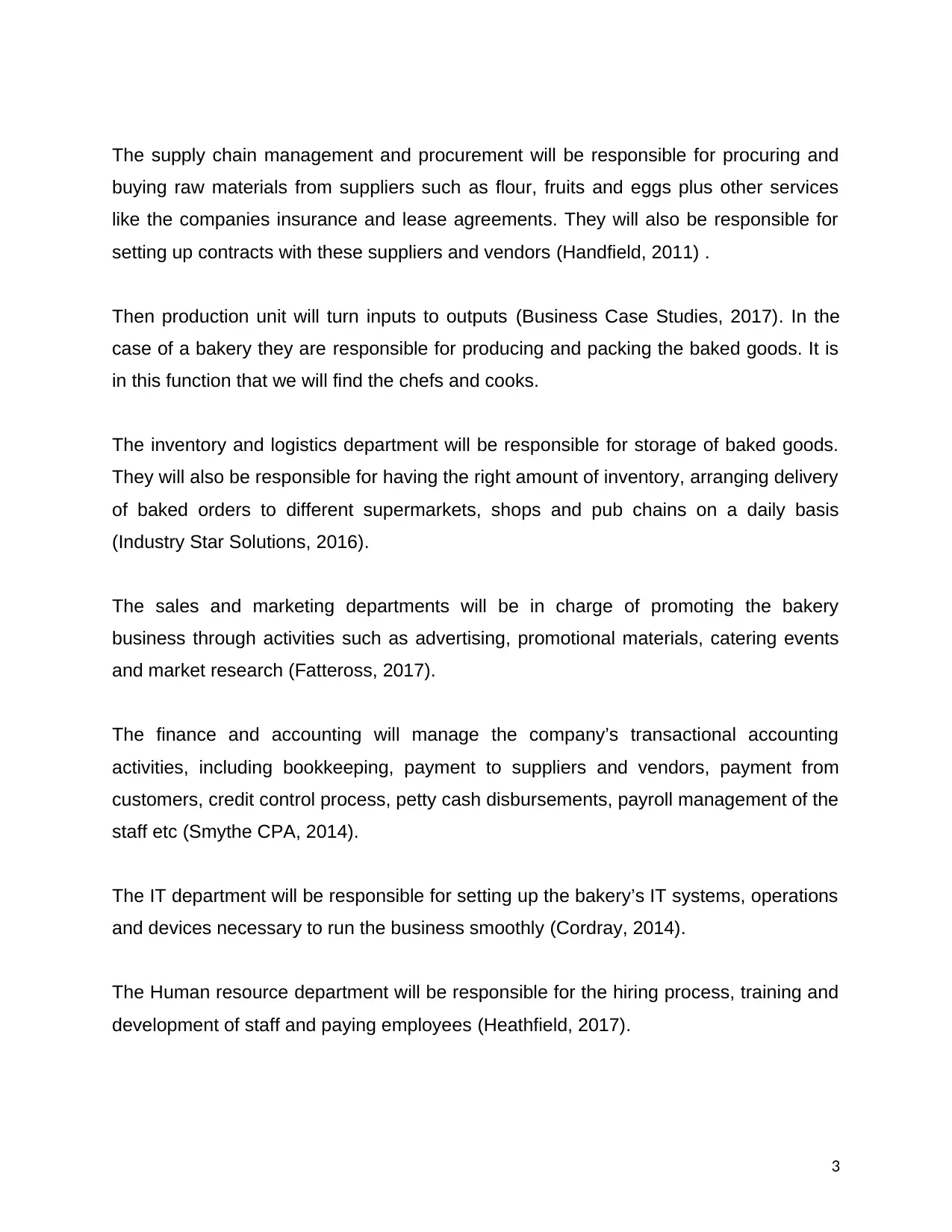
The supply chain management and procurement will be responsible for procuring and
buying raw materials from suppliers such as flour, fruits and eggs plus other services
like the companies insurance and lease agreements. They will also be responsible for
setting up contracts with these suppliers and vendors (Handfield, 2011) .
Then production unit will turn inputs to outputs (Business Case Studies, 2017). In the
case of a bakery they are responsible for producing and packing the baked goods. It is
in this function that we will find the chefs and cooks.
The inventory and logistics department will be responsible for storage of baked goods.
They will also be responsible for having the right amount of inventory, arranging delivery
of baked orders to different supermarkets, shops and pub chains on a daily basis
(Industry Star Solutions, 2016).
The sales and marketing departments will be in charge of promoting the bakery
business through activities such as advertising, promotional materials, catering events
and market research (Fatteross, 2017).
The finance and accounting will manage the company’s transactional accounting
activities, including bookkeeping, payment to suppliers and vendors, payment from
customers, credit control process, petty cash disbursements, payroll management of the
staff etc (Smythe CPA, 2014).
The IT department will be responsible for setting up the bakery’s IT systems, operations
and devices necessary to run the business smoothly (Cordray, 2014).
The Human resource department will be responsible for the hiring process, training and
development of staff and paying employees (Heathfield, 2017).
3
buying raw materials from suppliers such as flour, fruits and eggs plus other services
like the companies insurance and lease agreements. They will also be responsible for
setting up contracts with these suppliers and vendors (Handfield, 2011) .
Then production unit will turn inputs to outputs (Business Case Studies, 2017). In the
case of a bakery they are responsible for producing and packing the baked goods. It is
in this function that we will find the chefs and cooks.
The inventory and logistics department will be responsible for storage of baked goods.
They will also be responsible for having the right amount of inventory, arranging delivery
of baked orders to different supermarkets, shops and pub chains on a daily basis
(Industry Star Solutions, 2016).
The sales and marketing departments will be in charge of promoting the bakery
business through activities such as advertising, promotional materials, catering events
and market research (Fatteross, 2017).
The finance and accounting will manage the company’s transactional accounting
activities, including bookkeeping, payment to suppliers and vendors, payment from
customers, credit control process, petty cash disbursements, payroll management of the
staff etc (Smythe CPA, 2014).
The IT department will be responsible for setting up the bakery’s IT systems, operations
and devices necessary to run the business smoothly (Cordray, 2014).
The Human resource department will be responsible for the hiring process, training and
development of staff and paying employees (Heathfield, 2017).
3
Paraphrase This Document
Need a fresh take? Get an instant paraphrase of this document with our AI Paraphraser
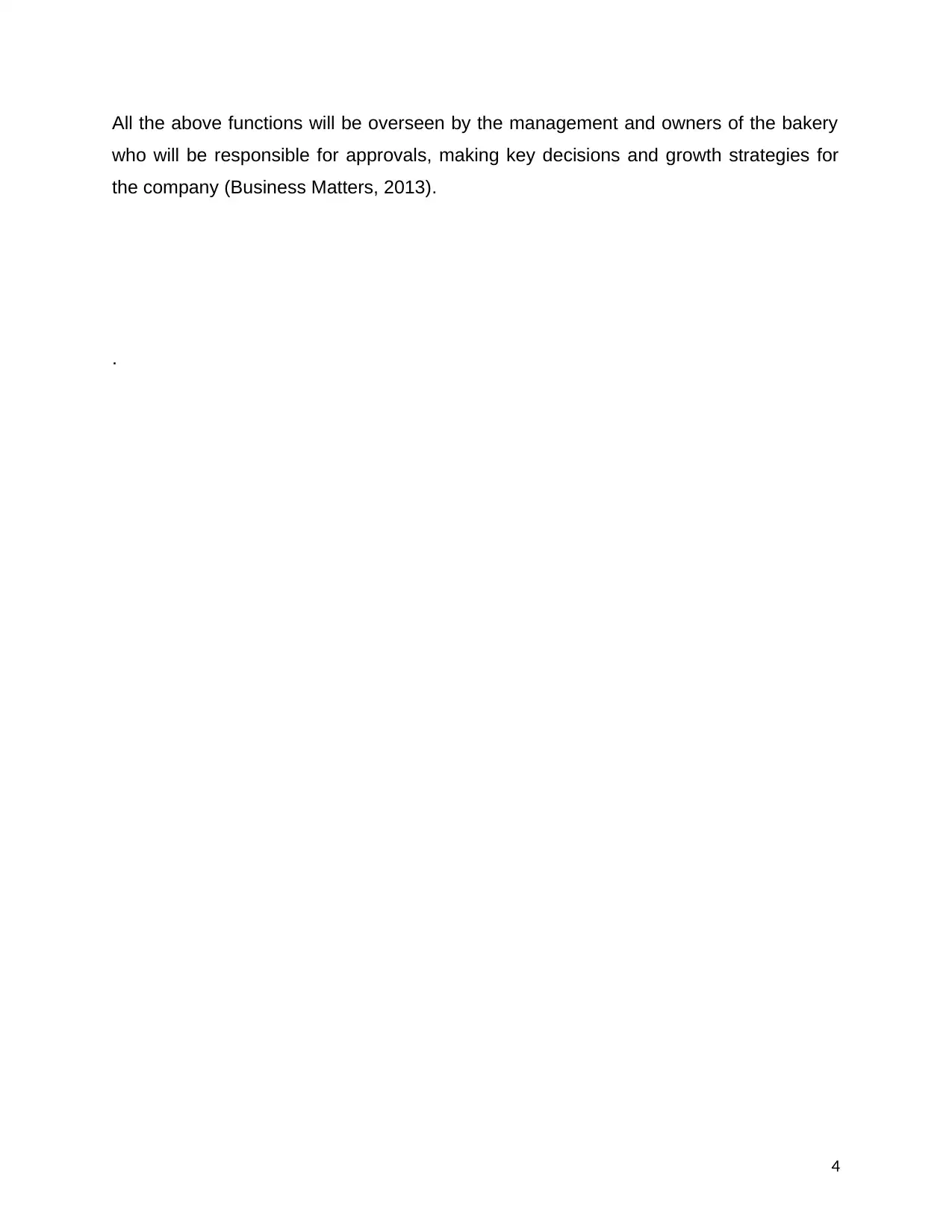
All the above functions will be overseen by the management and owners of the bakery
who will be responsible for approvals, making key decisions and growth strategies for
the company (Business Matters, 2013).
.
4
who will be responsible for approvals, making key decisions and growth strategies for
the company (Business Matters, 2013).
.
4
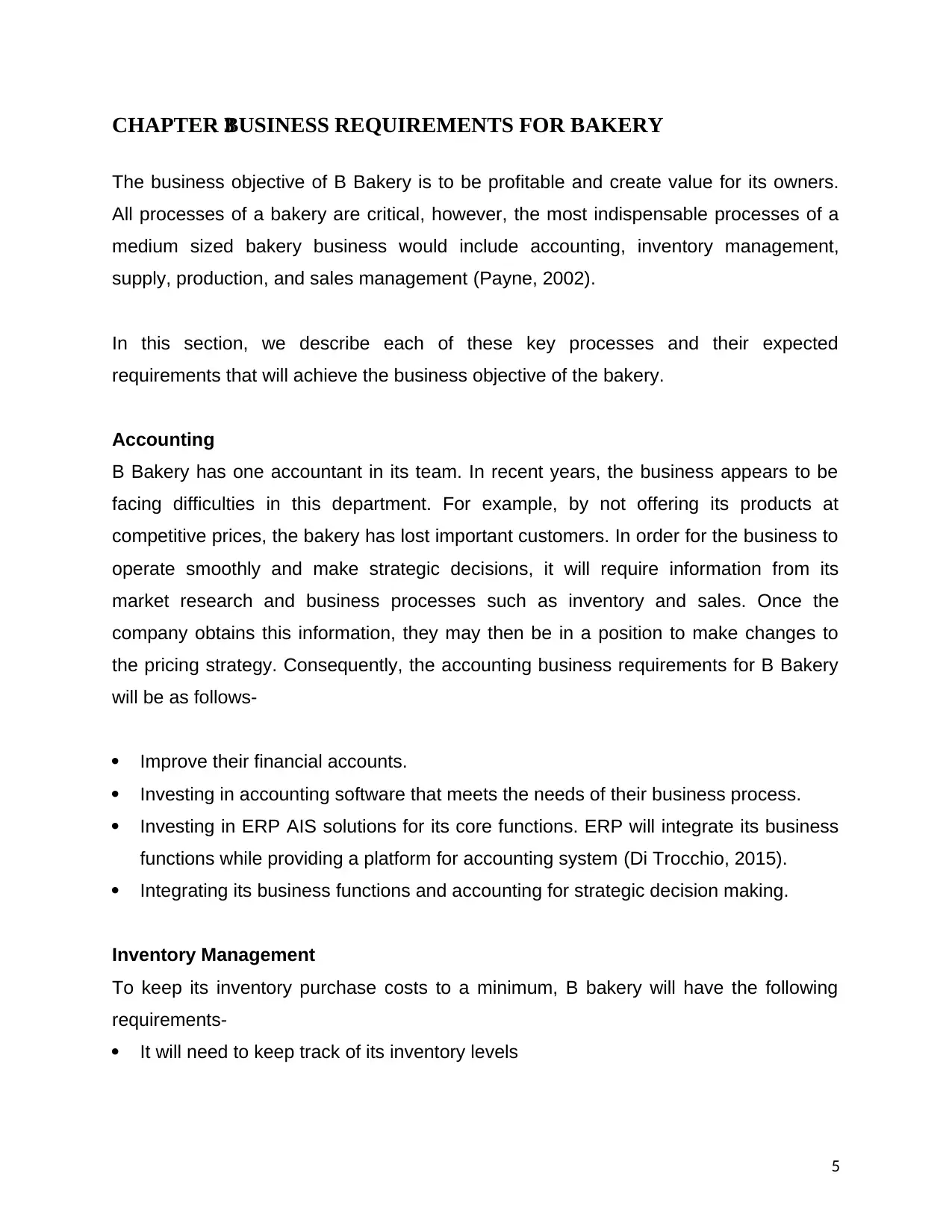
CHAPTER 3: BUSINESS REQUIREMENTS FOR BAKERY
The business objective of B Bakery is to be profitable and create value for its owners.
All processes of a bakery are critical, however, the most indispensable processes of a
medium sized bakery business would include accounting, inventory management,
supply, production, and sales management (Payne, 2002).
In this section, we describe each of these key processes and their expected
requirements that will achieve the business objective of the bakery.
Accounting
B Bakery has one accountant in its team. In recent years, the business appears to be
facing difficulties in this department. For example, by not offering its products at
competitive prices, the bakery has lost important customers. In order for the business to
operate smoothly and make strategic decisions, it will require information from its
market research and business processes such as inventory and sales. Once the
company obtains this information, they may then be in a position to make changes to
the pricing strategy. Consequently, the accounting business requirements for B Bakery
will be as follows-
Improve their financial accounts.
Investing in accounting software that meets the needs of their business process.
Investing in ERP AIS solutions for its core functions. ERP will integrate its business
functions while providing a platform for accounting system (Di Trocchio, 2015).
Integrating its business functions and accounting for strategic decision making.
Inventory Management
To keep its inventory purchase costs to a minimum, B bakery will have the following
requirements-
It will need to keep track of its inventory levels
5
The business objective of B Bakery is to be profitable and create value for its owners.
All processes of a bakery are critical, however, the most indispensable processes of a
medium sized bakery business would include accounting, inventory management,
supply, production, and sales management (Payne, 2002).
In this section, we describe each of these key processes and their expected
requirements that will achieve the business objective of the bakery.
Accounting
B Bakery has one accountant in its team. In recent years, the business appears to be
facing difficulties in this department. For example, by not offering its products at
competitive prices, the bakery has lost important customers. In order for the business to
operate smoothly and make strategic decisions, it will require information from its
market research and business processes such as inventory and sales. Once the
company obtains this information, they may then be in a position to make changes to
the pricing strategy. Consequently, the accounting business requirements for B Bakery
will be as follows-
Improve their financial accounts.
Investing in accounting software that meets the needs of their business process.
Investing in ERP AIS solutions for its core functions. ERP will integrate its business
functions while providing a platform for accounting system (Di Trocchio, 2015).
Integrating its business functions and accounting for strategic decision making.
Inventory Management
To keep its inventory purchase costs to a minimum, B bakery will have the following
requirements-
It will need to keep track of its inventory levels
5
⊘ This is a preview!⊘
Do you want full access?
Subscribe today to unlock all pages.

Trusted by 1+ million students worldwide
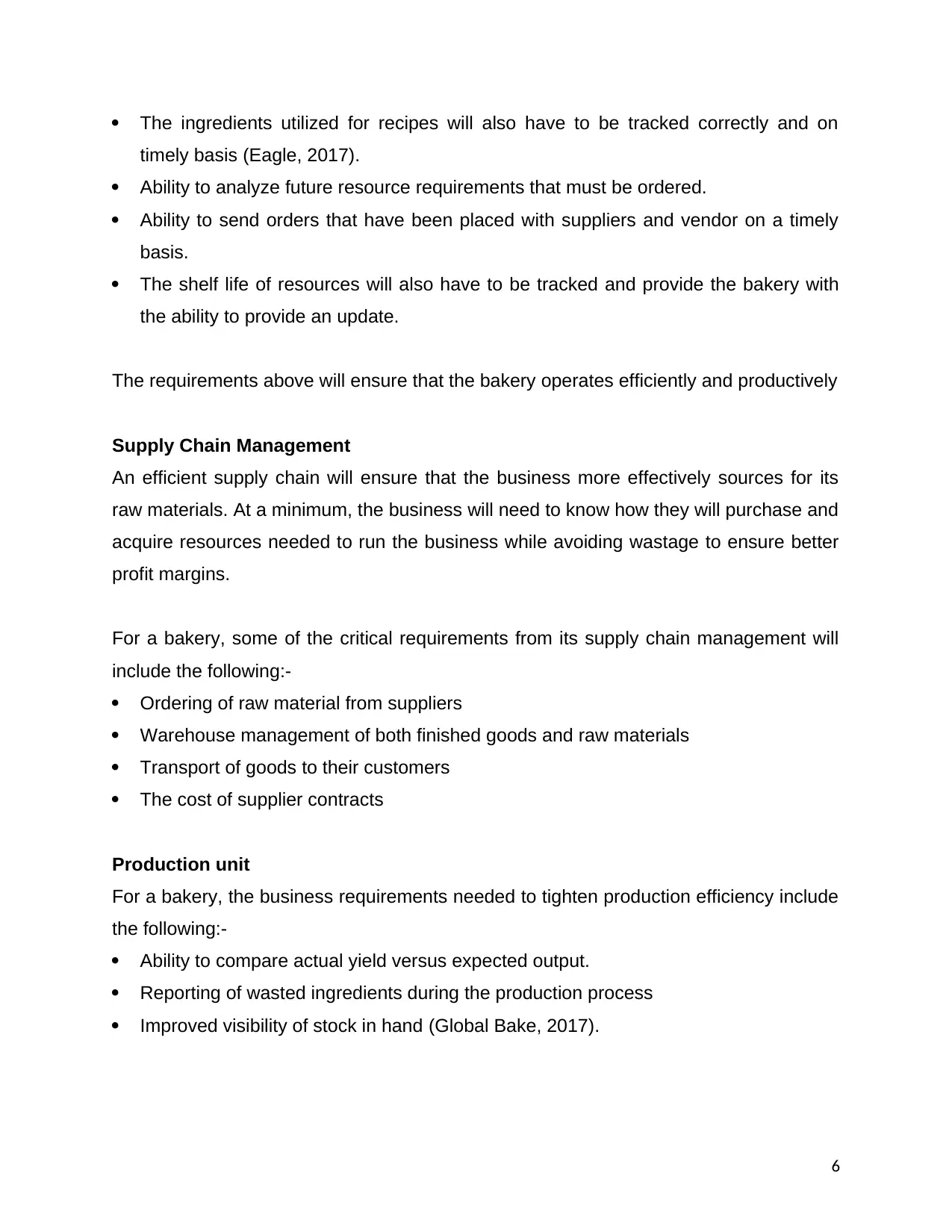
The ingredients utilized for recipes will also have to be tracked correctly and on
timely basis (Eagle, 2017).
Ability to analyze future resource requirements that must be ordered.
Ability to send orders that have been placed with suppliers and vendor on a timely
basis.
The shelf life of resources will also have to be tracked and provide the bakery with
the ability to provide an update.
The requirements above will ensure that the bakery operates efficiently and productively
Supply Chain Management
An efficient supply chain will ensure that the business more effectively sources for its
raw materials. At a minimum, the business will need to know how they will purchase and
acquire resources needed to run the business while avoiding wastage to ensure better
profit margins.
For a bakery, some of the critical requirements from its supply chain management will
include the following:-
Ordering of raw material from suppliers
Warehouse management of both finished goods and raw materials
Transport of goods to their customers
The cost of supplier contracts
Production unit
For a bakery, the business requirements needed to tighten production efficiency include
the following:-
Ability to compare actual yield versus expected output.
Reporting of wasted ingredients during the production process
Improved visibility of stock in hand (Global Bake, 2017).
6
timely basis (Eagle, 2017).
Ability to analyze future resource requirements that must be ordered.
Ability to send orders that have been placed with suppliers and vendor on a timely
basis.
The shelf life of resources will also have to be tracked and provide the bakery with
the ability to provide an update.
The requirements above will ensure that the bakery operates efficiently and productively
Supply Chain Management
An efficient supply chain will ensure that the business more effectively sources for its
raw materials. At a minimum, the business will need to know how they will purchase and
acquire resources needed to run the business while avoiding wastage to ensure better
profit margins.
For a bakery, some of the critical requirements from its supply chain management will
include the following:-
Ordering of raw material from suppliers
Warehouse management of both finished goods and raw materials
Transport of goods to their customers
The cost of supplier contracts
Production unit
For a bakery, the business requirements needed to tighten production efficiency include
the following:-
Ability to compare actual yield versus expected output.
Reporting of wasted ingredients during the production process
Improved visibility of stock in hand (Global Bake, 2017).
6
Paraphrase This Document
Need a fresh take? Get an instant paraphrase of this document with our AI Paraphraser
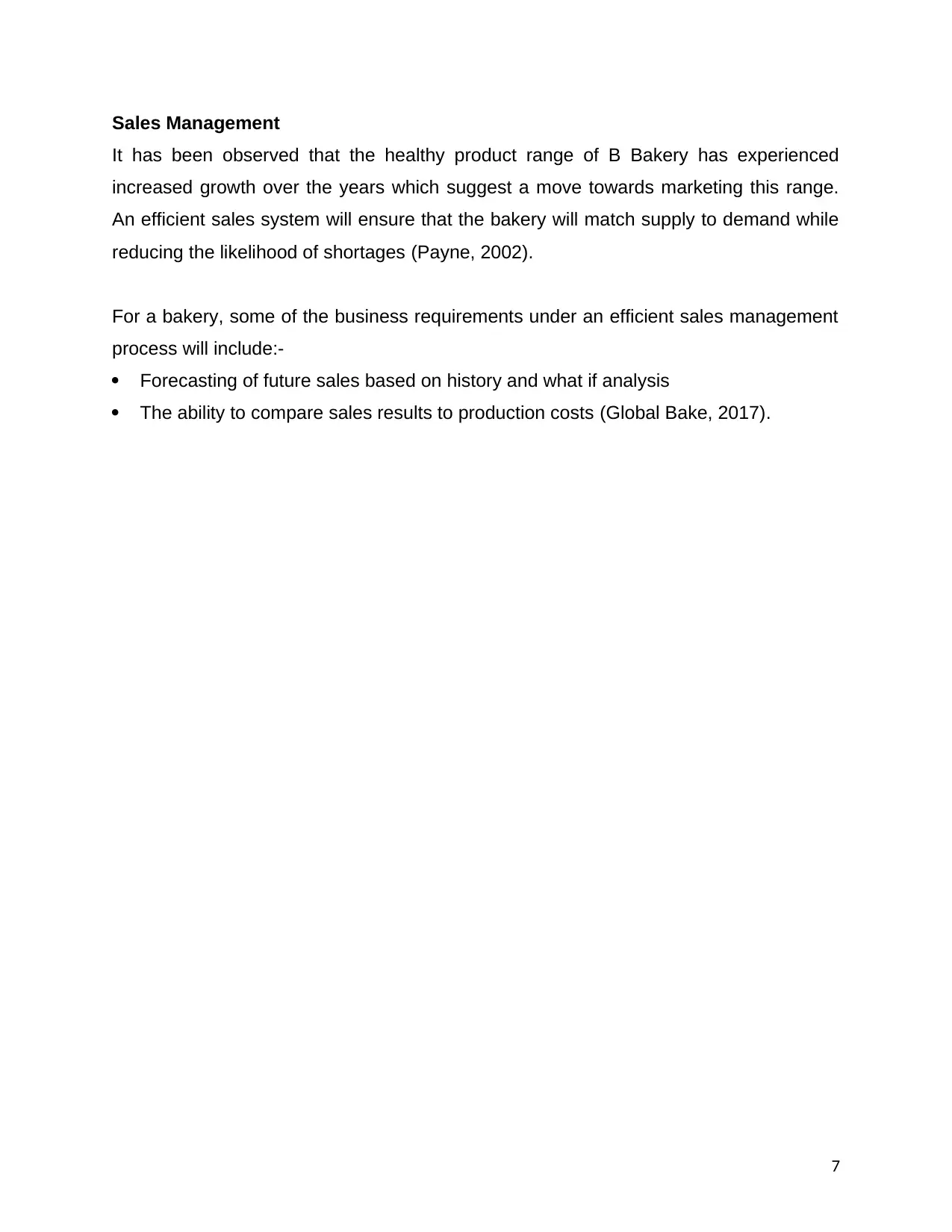
Sales Management
It has been observed that the healthy product range of B Bakery has experienced
increased growth over the years which suggest a move towards marketing this range.
An efficient sales system will ensure that the bakery will match supply to demand while
reducing the likelihood of shortages (Payne, 2002).
For a bakery, some of the business requirements under an efficient sales management
process will include:-
Forecasting of future sales based on history and what if analysis
The ability to compare sales results to production costs (Global Bake, 2017).
7
It has been observed that the healthy product range of B Bakery has experienced
increased growth over the years which suggest a move towards marketing this range.
An efficient sales system will ensure that the bakery will match supply to demand while
reducing the likelihood of shortages (Payne, 2002).
For a bakery, some of the business requirements under an efficient sales management
process will include:-
Forecasting of future sales based on history and what if analysis
The ability to compare sales results to production costs (Global Bake, 2017).
7
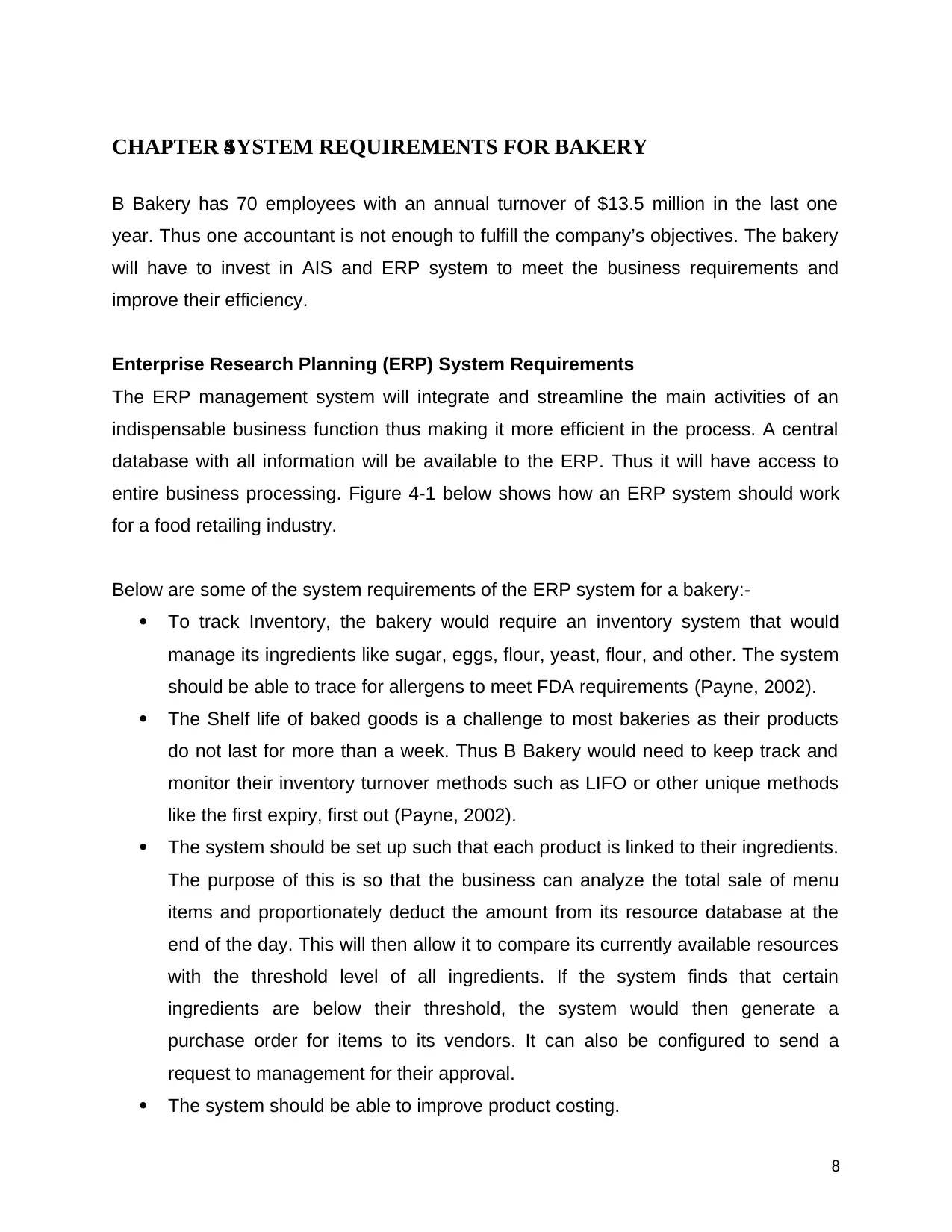
CHAPTER 4: SYSTEM REQUIREMENTS FOR BAKERY
B Bakery has 70 employees with an annual turnover of $13.5 million in the last one
year. Thus one accountant is not enough to fulfill the company’s objectives. The bakery
will have to invest in AIS and ERP system to meet the business requirements and
improve their efficiency.
Enterprise Research Planning (ERP) System Requirements
The ERP management system will integrate and streamline the main activities of an
indispensable business function thus making it more efficient in the process. A central
database with all information will be available to the ERP. Thus it will have access to
entire business processing. Figure 4-1 below shows how an ERP system should work
for a food retailing industry.
Below are some of the system requirements of the ERP system for a bakery:-
To track Inventory, the bakery would require an inventory system that would
manage its ingredients like sugar, eggs, flour, yeast, flour, and other. The system
should be able to trace for allergens to meet FDA requirements (Payne, 2002).
The Shelf life of baked goods is a challenge to most bakeries as their products
do not last for more than a week. Thus B Bakery would need to keep track and
monitor their inventory turnover methods such as LIFO or other unique methods
like the first expiry, first out (Payne, 2002).
The system should be set up such that each product is linked to their ingredients.
The purpose of this is so that the business can analyze the total sale of menu
items and proportionately deduct the amount from its resource database at the
end of the day. This will then allow it to compare its currently available resources
with the threshold level of all ingredients. If the system finds that certain
ingredients are below their threshold, the system would then generate a
purchase order for items to its vendors. It can also be configured to send a
request to management for their approval.
The system should be able to improve product costing.
8
B Bakery has 70 employees with an annual turnover of $13.5 million in the last one
year. Thus one accountant is not enough to fulfill the company’s objectives. The bakery
will have to invest in AIS and ERP system to meet the business requirements and
improve their efficiency.
Enterprise Research Planning (ERP) System Requirements
The ERP management system will integrate and streamline the main activities of an
indispensable business function thus making it more efficient in the process. A central
database with all information will be available to the ERP. Thus it will have access to
entire business processing. Figure 4-1 below shows how an ERP system should work
for a food retailing industry.
Below are some of the system requirements of the ERP system for a bakery:-
To track Inventory, the bakery would require an inventory system that would
manage its ingredients like sugar, eggs, flour, yeast, flour, and other. The system
should be able to trace for allergens to meet FDA requirements (Payne, 2002).
The Shelf life of baked goods is a challenge to most bakeries as their products
do not last for more than a week. Thus B Bakery would need to keep track and
monitor their inventory turnover methods such as LIFO or other unique methods
like the first expiry, first out (Payne, 2002).
The system should be set up such that each product is linked to their ingredients.
The purpose of this is so that the business can analyze the total sale of menu
items and proportionately deduct the amount from its resource database at the
end of the day. This will then allow it to compare its currently available resources
with the threshold level of all ingredients. If the system finds that certain
ingredients are below their threshold, the system would then generate a
purchase order for items to its vendors. It can also be configured to send a
request to management for their approval.
The system should be able to improve product costing.
8
⊘ This is a preview!⊘
Do you want full access?
Subscribe today to unlock all pages.

Trusted by 1+ million students worldwide
1 out of 22
Related Documents
Your All-in-One AI-Powered Toolkit for Academic Success.
+13062052269
info@desklib.com
Available 24*7 on WhatsApp / Email
![[object Object]](/_next/static/media/star-bottom.7253800d.svg)
Unlock your academic potential
Copyright © 2020–2025 A2Z Services. All Rights Reserved. Developed and managed by ZUCOL.





